Mehdi Boukhechba
AudioInsight: Detecting Social Contexts Relevant to Social Anxiety from Speech
Jul 19, 2024

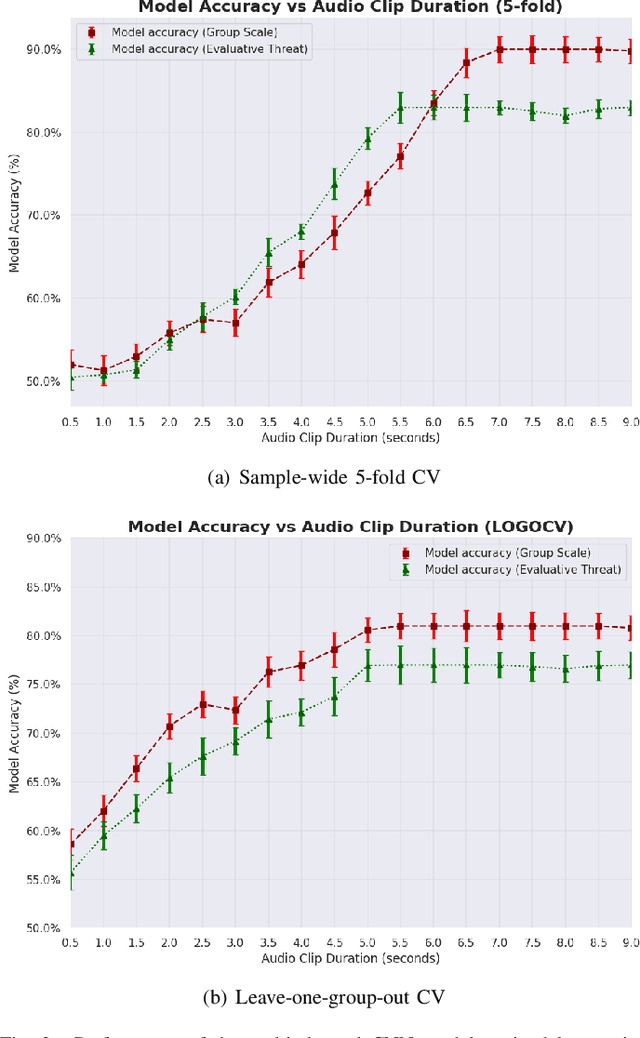
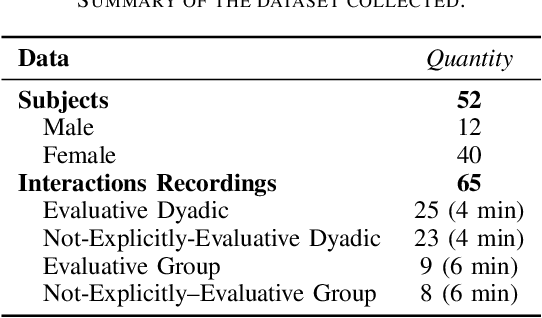
Abstract:During social interactions, understanding the intricacies of the context can be vital, particularly for socially anxious individuals. While previous research has found that the presence of a social interaction can be detected from ambient audio, the nuances within social contexts, which influence how anxiety provoking interactions are, remain largely unexplored. As an alternative to traditional, burdensome methods like self-report, this study presents a novel approach that harnesses ambient audio segments to detect social threat contexts. We focus on two key dimensions: number of interaction partners (dyadic vs. group) and degree of evaluative threat (explicitly evaluative vs. not explicitly evaluative). Building on data from a Zoom-based social interaction study (N=52 college students, of whom the majority N=45 are socially anxious), we employ deep learning methods to achieve strong detection performance. Under sample-wide 5-fold Cross Validation (CV), our model distinguished dyadic from group interactions with 90\% accuracy and detected evaluative threat at 83\%. Using a leave-one-group-out CV, accuracies were 82\% and 77\%, respectively. While our data are based on virtual interactions due to pandemic constraints, our method has the potential to extend to diverse real-world settings. This research underscores the potential of passive sensing and AI to differentiate intricate social contexts, and may ultimately advance the ability of context-aware digital interventions to offer personalized mental health support.
Incremental Semi-supervised Federated Learning for Health Inference via Mobile Sensing
Dec 19, 2023Abstract:Mobile sensing appears as a promising solution for health inference problem (e.g., influenza-like symptom recognition) by leveraging diverse smart sensors to capture fine-grained information about human behaviors and ambient contexts. Centralized training of machine learning models can place mobile users' sensitive information under privacy risks due to data breach and misexploitation. Federated Learning (FL) enables mobile devices to collaboratively learn global models without the exposure of local private data. However, there are challenges of on-device FL deployment using mobile sensing: 1) long-term and continuously collected mobile sensing data may exhibit domain shifts as sensing objects (e.g. humans) have varying behaviors as a result of internal and/or external stimulus; 2) model retraining using all available data may increase computation and memory burden; and 3) the sparsity of annotated crowd-sourced data causes supervised FL to lack robustness. In this work, we propose FedMobile, an incremental semi-supervised federated learning algorithm, to train models semi-supervisedly and incrementally in a decentralized online fashion. We evaluate FedMobile using a real-world mobile sensing dataset for influenza-like symptom recognition. Our empirical results show that FedMobile-trained models achieve the best results in comparison to the selected baseline methods.
Personalized State Anxiety Detection: An Empirical Study with Linguistic Biomarkers and A Machine Learning Pipeline
Apr 19, 2023Abstract:Individuals high in social anxiety symptoms often exhibit elevated state anxiety in social situations. Research has shown it is possible to detect state anxiety by leveraging digital biomarkers and machine learning techniques. However, most existing work trains models on an entire group of participants, failing to capture individual differences in their psychological and behavioral responses to social contexts. To address this concern, in Study 1, we collected linguistic data from N=35 high socially anxious participants in a variety of social contexts, finding that digital linguistic biomarkers significantly differ between evaluative vs. non-evaluative social contexts and between individuals having different trait psychological symptoms, suggesting the likely importance of personalized approaches to detect state anxiety. In Study 2, we used the same data and results from Study 1 to model a multilayer personalized machine learning pipeline to detect state anxiety that considers contextual and individual differences. This personalized model outperformed the baseline F1-score by 28.0%. Results suggest that state anxiety can be more accurately detected with personalized machine learning approaches, and that linguistic biomarkers hold promise for identifying periods of state anxiety in an unobtrusive way.
Wearable Sensor-based Multimodal Physiological Responses of Socially Anxious Individuals across Social Contexts
Apr 03, 2023

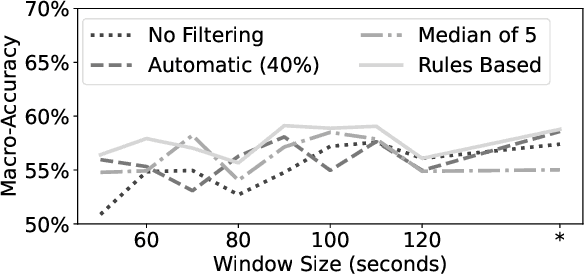
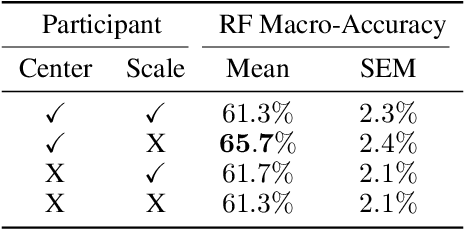
Abstract:Correctly identifying an individual's social context from passively worn sensors holds promise for delivering just-in-time adaptive interventions (JITAIs) to treat social anxiety disorder. In this study, we present results using passively collected data from a within-subject experiment that assessed physiological response across different social contexts (i.e, alone vs. with others), social phases (i.e., pre- and post-interaction vs. during an interaction), social interaction sizes (i.e., dyadic vs. group interactions), and levels of social threat (i.e., implicit vs. explicit social evaluation). Participants in the study ($N=46$) reported moderate to severe social anxiety symptoms as assessed by the Social Interaction Anxiety Scale ($\geq$34 out of 80). Univariate paired difference tests, multivariate random forest models, and follow-up cluster analyses were used to explore physiological response patterns across different social and non-social contexts. Our results suggest that social context is more reliably distinguishable than social phase, group size, or level of social threat, but that there is considerable variability in physiological response patterns even among these distinguishable contexts. Implications for real-world context detection and deployment of JITAIs are discussed.
Graph Neural Networks in IoT: A Survey
Mar 31, 2022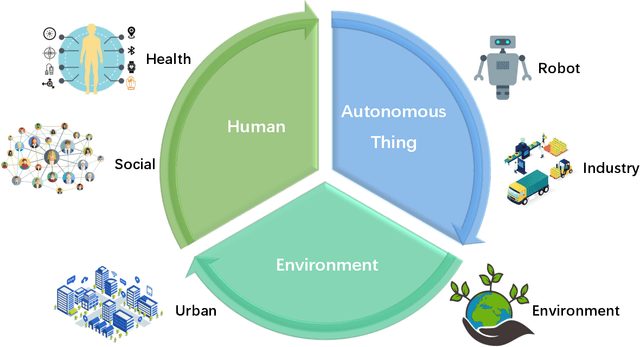
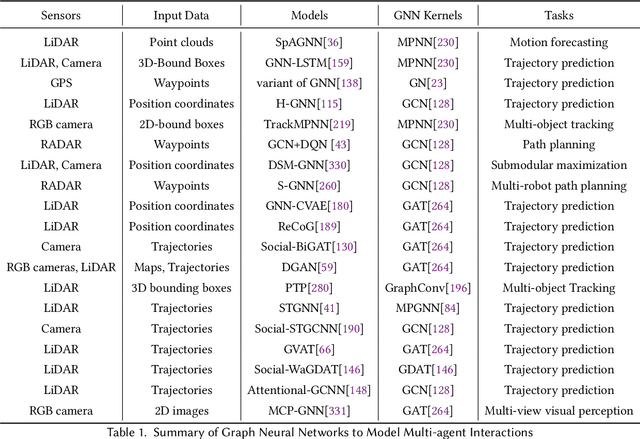

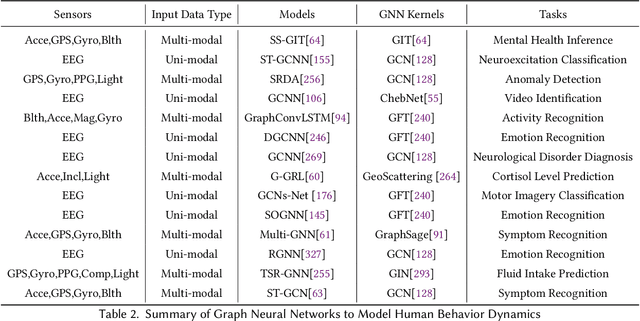
Abstract:The Internet of Things (IoT) boom has revolutionized almost every corner of people's daily lives: healthcare, home, transportation, manufacturing, supply chain, and so on. With the recent development of sensor and communication technologies, IoT devices including smart wearables, cameras, smartwatches, and autonomous vehicles can accurately measure and perceive their surrounding environment. Continuous sensing generates massive amounts of data and presents challenges for machine learning. Deep learning models (e.g., convolution neural networks and recurrent neural networks) have been extensively employed in solving IoT tasks by learning patterns from multi-modal sensory data. Graph Neural Networks (GNNs), an emerging and fast-growing family of neural network models, can capture complex interactions within sensor topology and have been demonstrated to achieve state-of-the-art results in numerous IoT learning tasks. In this survey, we present a comprehensive review of recent advances in the application of GNNs to the IoT field, including a deep dive analysis of GNN design in various IoT sensing environments, an overarching list of public data and source code from the collected publications, and future research directions. To keep track of newly published works, we collect representative papers and their open-source implementations and create a Github repository at https://github.com/GuiminDong/GNN4IoT.
Using Ballistocardiography for Sleep Stage Classification
Feb 15, 2022Abstract:A practical way of detecting sleep stages has become more necessary as we begin to learn about the vast effects that sleep has on people's lives. The current methods of sleep stage detection are expensive, invasive to a person's sleep, and not practical in a modern home setting. While the method of detecting sleep stages via the monitoring of brain activity, muscle activity, and eye movement, through electroencephalogram in a lab setting, provide the gold standard for detection, this paper aims to investigate a new method that will allow a person to gain similar insight and results with no obtrusion to their normal sleeping habits. Ballistocardiography (BCG) is a non-invasive sensing technology that collects information by measuring the ballistic forces generated by the heart. Using features extracted from BCG such as time of usage, heart rate, respiration rate, relative stroke volume, and heart rate variability, we propose to implement a sleep stage detection algorithm and compare it against sleep stages extracted from a Fitbit Sense Smart Watch. The accessibility, ease of use, and relatively-low cost of the BCG offers many applications and advantages for using this device. By standardizing this device, people will be able to benefit from the BCG in analyzing their own sleep patterns and draw conclusions on their sleep efficiency. This work demonstrates the feasibility of using BCG for an accurate and non-invasive sleep monitoring method that can be set up in the comfort of a one's personal sleep environment.
From Personalized Medicine to Population Health: A Survey of mHealth Sensing Techniques
Jul 02, 2021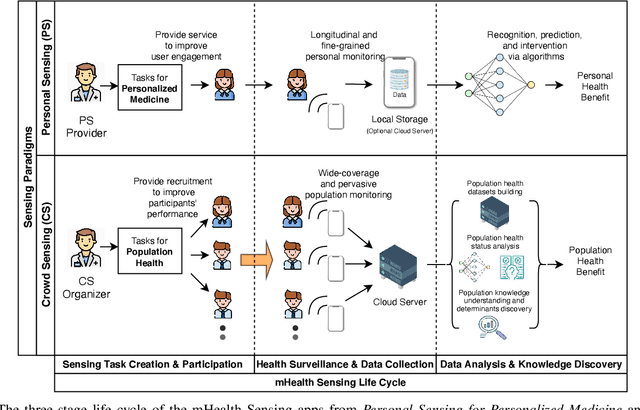
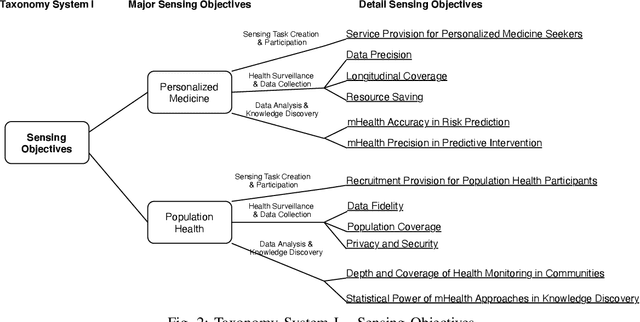
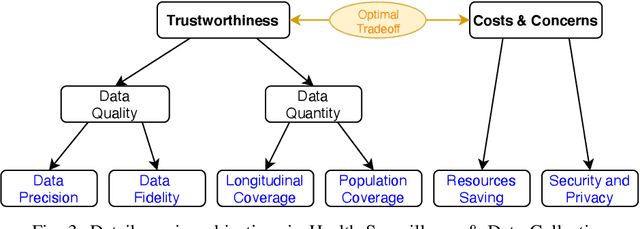
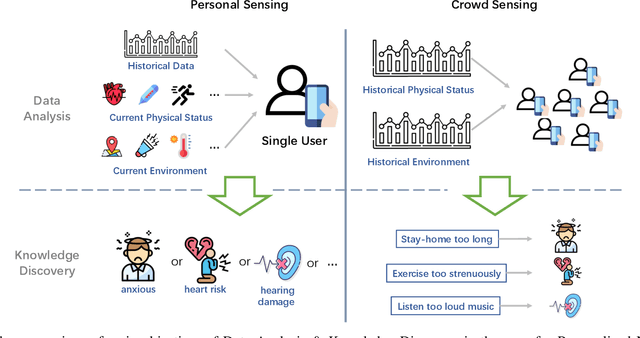
Abstract:Mobile Sensing Apps have been widely used as a practical approach to collect behavioral and health-related information from individuals and provide timely intervention to promote health and well-beings, such as mental health and chronic cares. As the objectives of mobile sensing could be either \emph{(a) personalized medicine for individuals} or \emph{(b) public health for populations}, in this work we review the design of these mobile sensing apps, and propose to categorize the design of these apps/systems in two paradigms -- \emph{(i) Personal Sensing} and \emph{(ii) Crowd Sensing} paradigms. While both sensing paradigms might incorporate with common ubiquitous sensing technologies, such as wearable sensors, mobility monitoring, mobile data offloading, and/or cloud-based data analytics to collect and process sensing data from individuals, we present a novel taxonomy system with two major components that can specify and classify apps/systems from aspects of the life-cycle of mHealth Sensing: \emph{(1) Sensing Task Creation \& Participation}, \emph{(2) Health Surveillance \& Data Collection}, and \emph{(3) Data Analysis \& Knowledge Discovery}. With respect to different goals of the two paradigms, this work systematically reviews this field, and summarizes the design of typical apps/systems in the view of the configurations and interactions between these two components. In addition to summarization, the proposed taxonomy system also helps figure out the potential directions of mobile sensing for health from both personalized medicines and population health perspectives.
Sparse Longitudinal Representations of Electronic Health Record Data for the Early Detection of Chronic Kidney Disease in Diabetic Patients
Nov 09, 2020
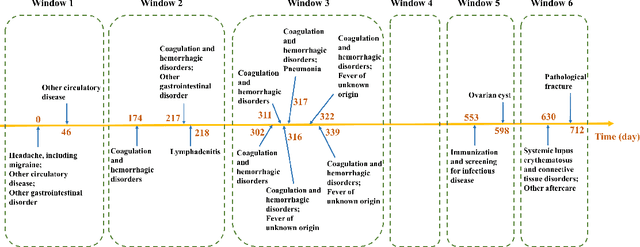
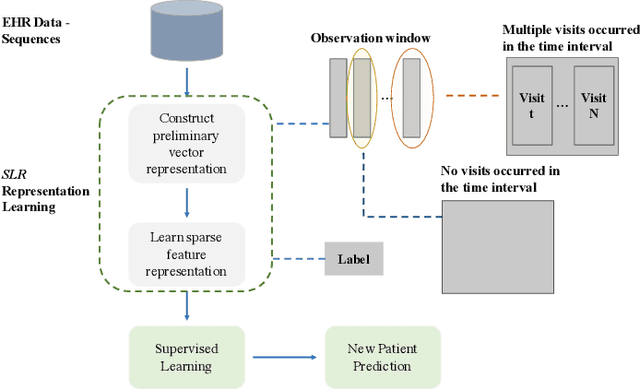
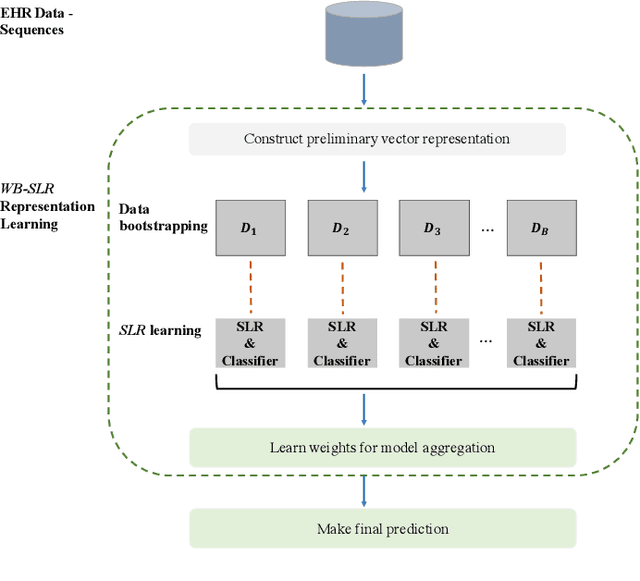
Abstract:Chronic kidney disease (CKD) is a gradual loss of renal function over time, and it increases the risk of mortality, decreased quality of life, as well as serious complications. The prevalence of CKD has been increasing in the last couple of decades, which is partly due to the increased prevalence of diabetes and hypertension. To accurately detect CKD in diabetic patients, we propose a novel framework to learn sparse longitudinal representations of patients' medical records. The proposed method is also compared with widely used baselines such as Aggregated Frequency Vector and Bag-of-Pattern in Sequences on real EHR data, and the experimental results indicate that the proposed model achieves higher predictive performance. Additionally, the learned representations are interpreted and visualized to bring clinical insights.
Offline Contextual Multi-armed Bandits for Mobile Health Interventions: A Case Study on Emotion Regulation
Aug 21, 2020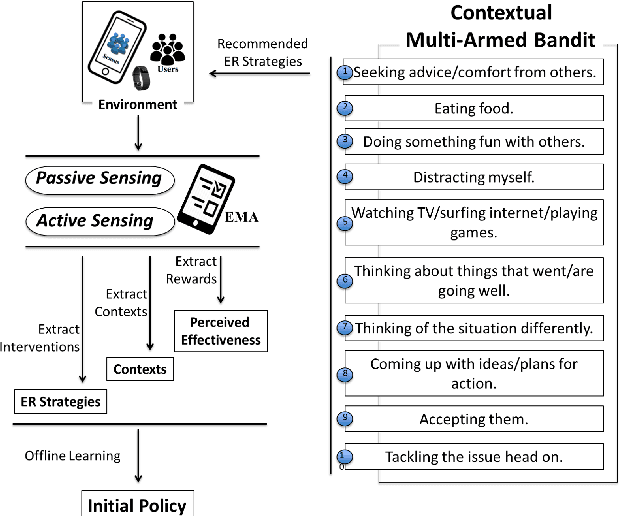
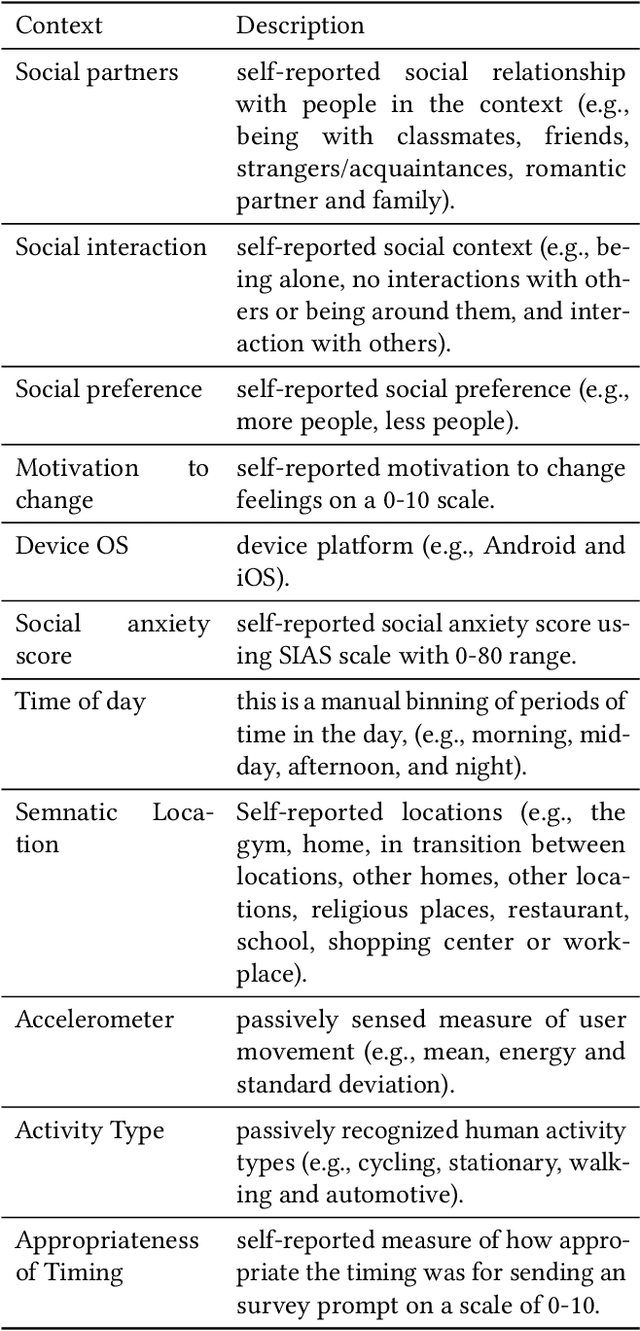

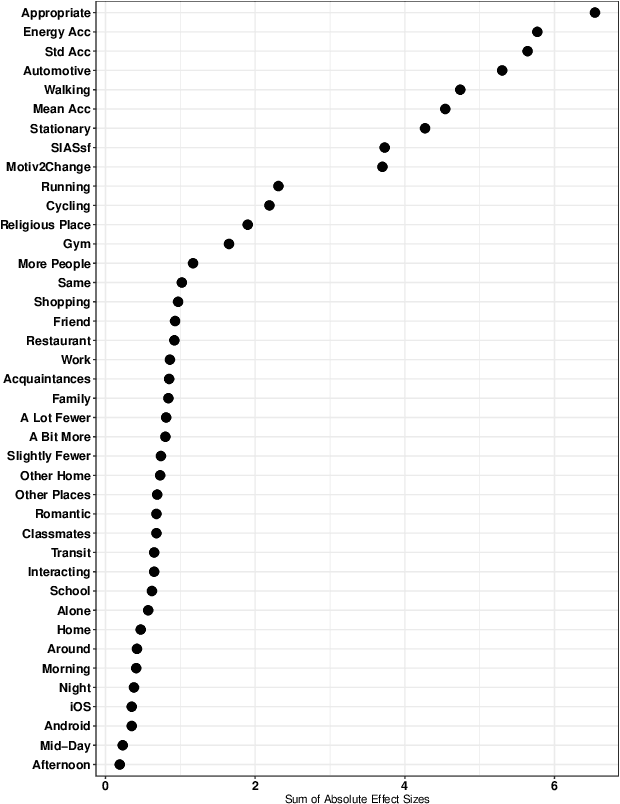
Abstract:Delivering treatment recommendations via pervasive electronic devices such as mobile phones has the potential to be a viable and scalable treatment medium for long-term health behavior management. But active experimentation of treatment options can be time-consuming, expensive and altogether unethical in some cases. There is a growing interest in methodological approaches that allow an experimenter to learn and evaluate the usefulness of a new treatment strategy before deployment. We present the first development of a treatment recommender system for emotion regulation using real-world historical mobile digital data from n = 114 high socially anxious participants to test the usefulness of new emotion regulation strategies. We explore a number of offline contextual bandits estimators for learning and propose a general framework for learning algorithms. Our experimentation shows that the proposed doubly robust offline learning algorithms performed significantly better than baseline approaches, suggesting that this type of recommender algorithm could improve emotion regulation. Given that emotion regulation is impaired across many mental illnesses and such a recommender algorithm could be scaled up easily, this approach holds potential to increase access to treatment for many people. We also share some insights that allow us to translate contextual bandit models to this complex real-world data, including which contextual features appear to be most important for predicting emotion regulation strategy effectiveness.
Enabling Smartphone-based Estimation of Heart Rate
Dec 18, 2019
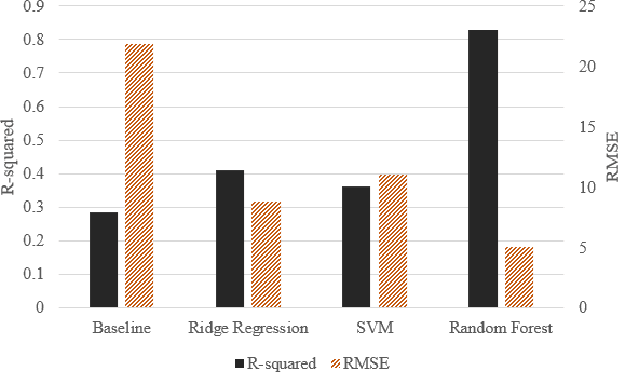
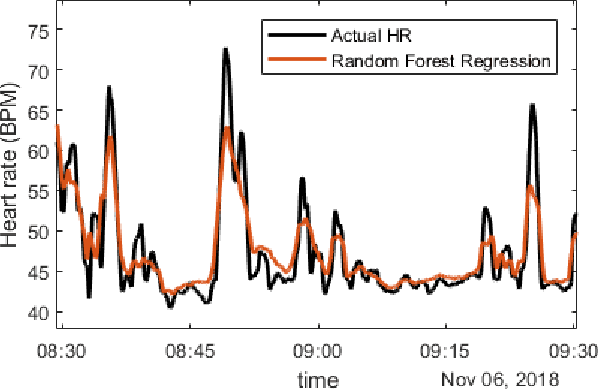
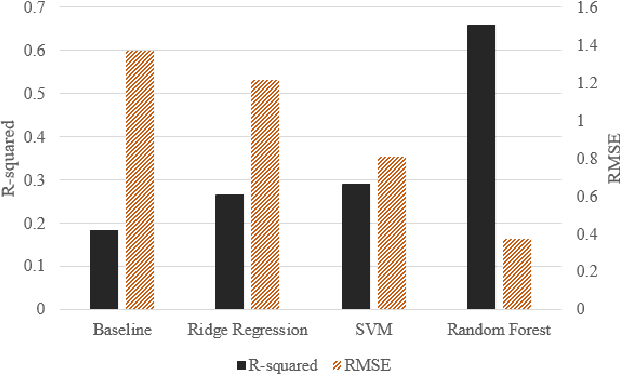
Abstract:Continuous, ubiquitous monitoring through wearable sensors has the potential to collect useful information about users' context. Heart rate is an important physiologic measure used in a wide variety of applications, such as fitness tracking and health monitoring. However, wearable sensors that monitor heart rate, such as smartwatches and electrocardiogram (ECG) patches, can have gaps in their data streams because of technical issues (e.g., bad wireless channels, battery depletion, etc.) or user-related reasons (e.g. motion artifacts, user compliance, etc.). The ability to use other available sensor data (e.g., smartphone data) to estimate missing heart rate readings is useful to cope with any such gaps, thus improving data quality and continuity. In this paper, we test the feasibility of estimating raw heart rate using smartphone sensor data. Using data generated by 12 participants in a one-week study period, we were able to build both personalized and generalized models using regression, SVM, and random forest algorithms. All three algorithms outperformed the baseline moving-average interpolation method for both personalized and generalized settings. Moreover, our findings suggest that personalized models outperformed the generalized models, which speaks to the importance of considering personal physiology, behavior, and life style in the estimation of heart rate. The promising results provide preliminary evidence of the feasibility of combining smartphone sensor data with wearable sensor data for continuous heart rate monitoring.
 Add to Chrome
Add to Chrome Add to Firefox
Add to Firefox Add to Edge
Add to Edge